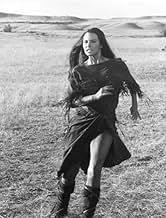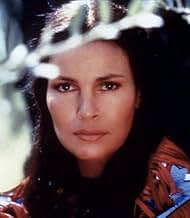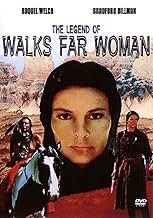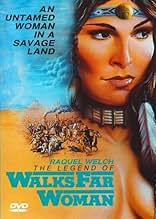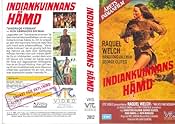अपनी भाषा में प्लॉट जोड़ेंA woman kills her husband after he becomes violently abusive following a concussion. The tribe then banishes her from the community.A woman kills her husband after he becomes violently abusive following a concussion. The tribe then banishes her from the community.A woman kills her husband after he becomes violently abusive following a concussion. The tribe then banishes her from the community.
- पुरस्कार
- कुल 1 जीत
Joanelle Romero
- Fire Wing
- (as Joannelle Nadine Romero)
कहानी
क्या आपको पता है
- ट्रिवियाThe real-life Walks Far Woman died in 1953 at the age of one hundred and two.
- कनेक्शनReferenced in The Tonight Show Starring Johnny Carson: Raquel Welch/Carl Reiner (1980)
फीचर्ड रिव्यू
Raquel Welch was, in her day, a big name in the cinema, but her career as a major Hollywood star was a surprisingly short one. It began with "Fantastic Voyage" and "One Million Years BC" in 1966 and ended with "Mother, Jugs and Speed" ten years later. (I don't count "The Prince and the Pauper" from 1977, as she only played a minor role despite her second billing). She was originally hired to appear in "Cannery Row" in 1982, but was sacked from the film without notice and without any good reason being given, and did not make any feature films during the whole of the eighties. Possibly producers were wary of her after the "Cannery Row" debacle and subsequent lawsuit in which she successfully sued the studio for breach of contract. Or perhaps the public had become too used to her as a sexy young glamour girl and could not accept her as a middle-aged woman, even though she retained her striking beauty throughout her forties and into her fifties.
Whatever the reasons, Raquel's output in the eighties was limited to a handful TV movies, and "The Legend of Walks Far Woman" was the first of these. (It was actually shot in 1979 but not broadcast until 1982). It was very much Raquel's own pet project, something she fought hard to get made. Doubtless she would have preferred a cinema release, but this was the period when the Western genre was in steep decline and few Westerns were being released as feature films.
The film is set in the Montana of the 1870s. The title character, Walks Far Woman, was apparently a real historical individual who died in 1953 at the age of 102. She was originally a member of the Blackfoot tribe, but had to leave that tribe after killing two men who had murdered her husband and was adopted as a member of the Sioux nation. The film deals with her life among the Sioux and her marriage to a handsome Sioux warrior named Horse's Ghost.
The film has given rise to some controversy in that some Native American characters are played by white actors, especially the role of Horse's Ghost, played by the Italian-born Nick Mancuso. (Raquel Welch herself is normally regarded as white, but does have some Native American ancestry). Nevertheless, the film is unusual in that it concentrates almost exclusively upon the Native American point of view. At one time Westerns were almost always made from the point of view of the white man, with the Indians depicted as bloodthirsty savages. This attitude began to change in the fifties and sixties, when films like "Broken Arrow" or "Cheyenne Autumn" began to present a more objective viewpoint, but such films generally included as one of the main characters a sympathetic, liberal white man, like James Stewart's Tom Jeffords in "Broken Arrow". ("Dances with Wolves" is a more recent example of this phenomenon).
In "The Legend of Walks Far Woman", by contrast, there are virtually no pure-blooded white characters, although a mixed-race trader does play an important part in the story. It can therefore be seen as a laudable attempt to tell the Native Americans' own story on its own terms, not simply the story of the white settlers' interactions with the Native Americans.
Like a number of recent Westerns, the film was attractively photographed, and I felt that Raquel Welch did a very good job as the heroine, proving that she is more than just a pretty face. (She was always good in comic or light-hearted roles, but some of her earlier attempts to prove herself in serious drama misfired. "Myra Breckinridge", for example, may have been intended as serious satire, but it was such a turkey that it ended up as an inadvertent comedy and actually damaged Welch's career).
Trying to appraise the film as a whole, however, is difficult, because I realise that the version I saw was only a truncated version of the original film. Apparently Raquel originally envisaged the film as being a grand epic, something like "Dances with Wolves" a decade earlier, and the original version shot in 1979 was around three hours in length. Unfortunately, when it was finally televised three years later, about an hour was cut, presumably to fit in with American TV schedules, which would explain why the ending seems very rushed, with Walks Far going in a matter of minutes from a young woman in her twenties or thirties to an old lady aged over 100. Provisionally, therefore, I would award this one a mark of 6/10, with the option of revising that should the full version ever be shown or released.
Whatever the reasons, Raquel's output in the eighties was limited to a handful TV movies, and "The Legend of Walks Far Woman" was the first of these. (It was actually shot in 1979 but not broadcast until 1982). It was very much Raquel's own pet project, something she fought hard to get made. Doubtless she would have preferred a cinema release, but this was the period when the Western genre was in steep decline and few Westerns were being released as feature films.
The film is set in the Montana of the 1870s. The title character, Walks Far Woman, was apparently a real historical individual who died in 1953 at the age of 102. She was originally a member of the Blackfoot tribe, but had to leave that tribe after killing two men who had murdered her husband and was adopted as a member of the Sioux nation. The film deals with her life among the Sioux and her marriage to a handsome Sioux warrior named Horse's Ghost.
The film has given rise to some controversy in that some Native American characters are played by white actors, especially the role of Horse's Ghost, played by the Italian-born Nick Mancuso. (Raquel Welch herself is normally regarded as white, but does have some Native American ancestry). Nevertheless, the film is unusual in that it concentrates almost exclusively upon the Native American point of view. At one time Westerns were almost always made from the point of view of the white man, with the Indians depicted as bloodthirsty savages. This attitude began to change in the fifties and sixties, when films like "Broken Arrow" or "Cheyenne Autumn" began to present a more objective viewpoint, but such films generally included as one of the main characters a sympathetic, liberal white man, like James Stewart's Tom Jeffords in "Broken Arrow". ("Dances with Wolves" is a more recent example of this phenomenon).
In "The Legend of Walks Far Woman", by contrast, there are virtually no pure-blooded white characters, although a mixed-race trader does play an important part in the story. It can therefore be seen as a laudable attempt to tell the Native Americans' own story on its own terms, not simply the story of the white settlers' interactions with the Native Americans.
Like a number of recent Westerns, the film was attractively photographed, and I felt that Raquel Welch did a very good job as the heroine, proving that she is more than just a pretty face. (She was always good in comic or light-hearted roles, but some of her earlier attempts to prove herself in serious drama misfired. "Myra Breckinridge", for example, may have been intended as serious satire, but it was such a turkey that it ended up as an inadvertent comedy and actually damaged Welch's career).
Trying to appraise the film as a whole, however, is difficult, because I realise that the version I saw was only a truncated version of the original film. Apparently Raquel originally envisaged the film as being a grand epic, something like "Dances with Wolves" a decade earlier, and the original version shot in 1979 was around three hours in length. Unfortunately, when it was finally televised three years later, about an hour was cut, presumably to fit in with American TV schedules, which would explain why the ending seems very rushed, with Walks Far going in a matter of minutes from a young woman in her twenties or thirties to an old lady aged over 100. Provisionally, therefore, I would award this one a mark of 6/10, with the option of revising that should the full version ever be shown or released.
- JamesHitchcock
- 10 अप्रैल 2010
- परमालिंक
टॉप पसंद
रेटिंग देने के लिए साइन-इन करें और वैयक्तिकृत सुझावों के लिए वॉचलिस्ट करें
विवरण
इस पेज में योगदान दें
किसी बदलाव का सुझाव दें या अनुपलब्ध कॉन्टेंट जोड़ें

टॉप गैप
By what name was The Legend of Walks Far Woman (1980) officially released in Canada in English?
जवाब
